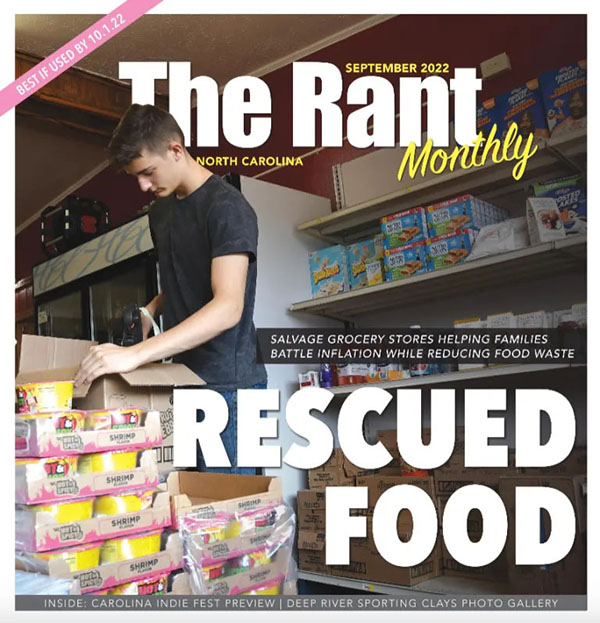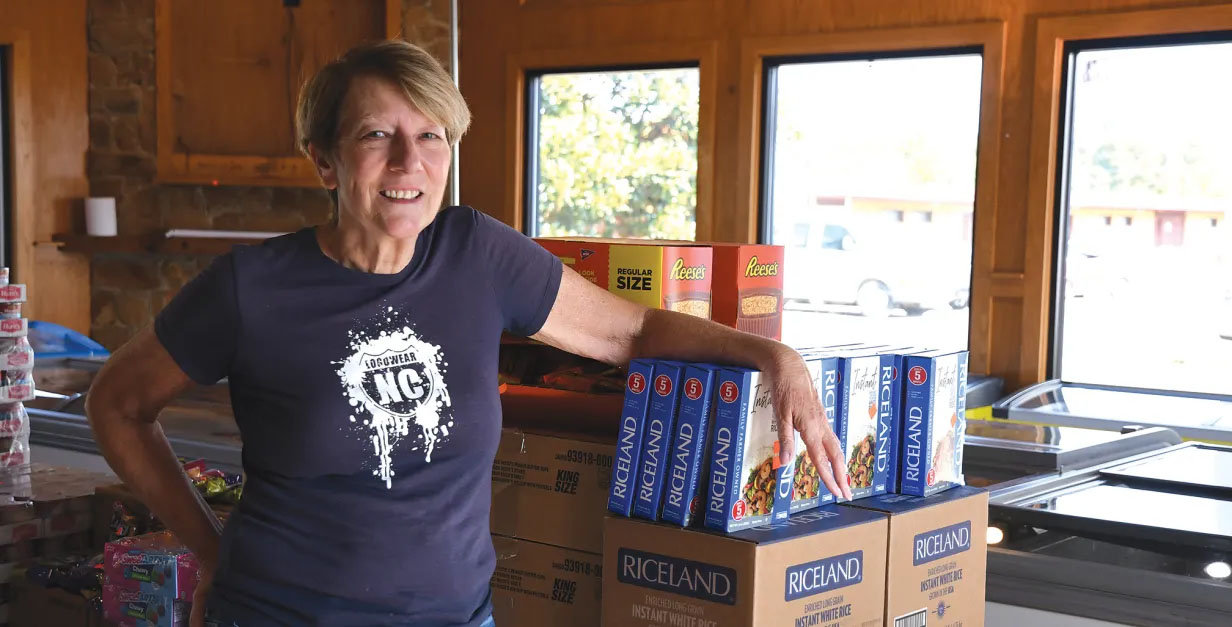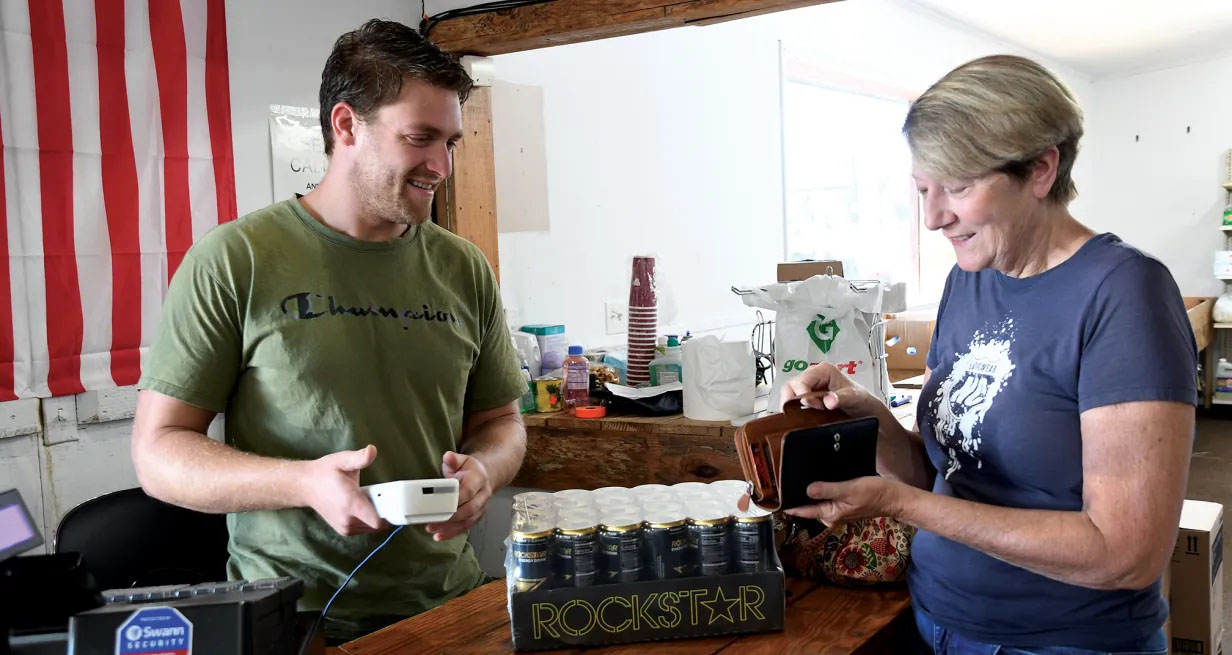This page contains affiliate links which support SalvageFood.org, a 501(c)(3) nonprofit, if you make a purchase.

Rescued Food | The Growing Need for Salvage Grocery Stores
Local woman’s efforts to promote salvage food stores — like the one that can be found in Sanford — aim to not only reduce food waste but help families battle ever-rising food costs
This article originally appeared in The Rant Monthly, September 2022 editionBy Billy Liggett
Lynne Ziobro’s food waste advocacy began with gourmet nuts. A friend of hers a few years back was dealing with the world’s largest online retailer — you know the one — trying to unload a large shipment of his product, and this “prime” retailer wouldn’t sell them because they were three months away from their suggested expiration date.
The retailer gave her friend two options: Take back the nuts or let them ship them to a landfill.
“My friend was very angry, because they were still perfectly good,” Ziobro recalls. “And I was angry, and it wasn’t even my business. I was scrambling to see if something else could be done. So I started to search for what to do with food that’s about to expire.”
That’s when Ziobro discovered salvage food stores. Think “grocery store,” but with food items that are often slightly damaged, close to or a little beyond a suggested “sell by” date or perfectly good bulk or seasonal items that are no longer being sold at chain grocery stores. She also discovered the enormous global problem of food waste — in the U.S. alone, about 40 percent of the food we produce goes uneaten, and about 95 percent of that uneaten food ends up in a landfill next to the gourmet nuts. Food also makes up most of our trash, accounting for 21 percent of everything we throw away.
Not only does this amount of food waste contribute to environmental problems, it doesn’t make sense in a country where millions of Americans go hungry every day.
In 2019, Ziobro, a Sanford resident with a background in web design, launched her own site, buysalvagefood.com, which began as a directory for salvage food stores across the country. The site has grown to include articles on salvage food tips, explanations of “best-by” and “sell-by” dates on food and the environmental and economic benefits of reducing food waste. Her web traffic jumped considerably in August following a New York Times article on salvage stores that quoted her and included a link to her site.
Ziobro has become an advocate on the subject, and her newfound passion led her to meet Daniel Smith, owner of Stretch-A-Buck salvage grocery store on Westover Drive (along U.S. 1 near Tramway) in Sanford. Stretch-A-Buck opened during the early months of the pandemic in 2020 and has quietly become a popular stop for those looking to save money on groceries and “treasure hunters” looking for great bargains on whatever shipments he takes in that week.

With grocery prices 13.1 percent higher than a year ago, as reported in that New York Times feature sourcing the Consumer Price Index in July, Ziobro believes salvage stores are now starting to find their niche. As the Times writes, “In a world where a jar of peanut butter costs a dollar more than it did last year and the price of a gallon of conventional milk inches up to $6 in some cities, paying $1.49 for a family-size box of crispy rice cereal can seem like a good idea, even if it’s August and the cereal is dyed red and green for Christmas. At the salvage store, a deal is a deal.”
Lynne Ziobro of Sanford launched her website — buysalvagefood.com — listing salvage food locations across the country.
“There are a lot of organizations out there like nonprofits that are all about preventing food waste,” Ziobro says. “But it seems to me that the whole concept of salvage grocery stores is completely ignored by them.”
So what are salvage grocery stores, and where does the food come from? According to Ziobro’s site, a salvage store — also known as a “bent-and-dent” or “banana box store” sells food items that are near or past their “best by” dates, items that are discontinued, seasonal merchandise that is out-of-season, overstocked inventory, products with slightly damaged packaging or items with label changes that were returned for various reasons. Manufacturers and large grocery retailers sell their unwanted items to food brokerage companies and liquidators at large discounts. The liquidators then distribute the items to salvage stores, dollar stores, food banks and discount stores all over the country.
Shoppers rarely know exactly what they’re getting on a certain day. On Aug. 26 at Stretch-A-Buck in Sanford, a large crate of Nutella hazelnut spread sat in the middle of the store at a discounted price — the “sell by” date on the lids still a full six months away. In September, it could be peanut butter or ranch style beans.
Like grocery stores and discount stores, salvage stores are regulated and inspected by the USDA. With the exception of baby formula, the federal government does not regulate expiration dates on food, and state laws vary. In North Carolina, it’s legal to sell food items that are past their expiration date, with the exception of baby formula and over-the-counter drugs.
In her “tips for buying from salvage grocery stores” article on her site, Ziobro offers shoppers a guide on what to look for when scanning the shelves — bulges in canned food items or dents along the seams can mean bacteria growth inside, and stains on frozen meat can suggest the meat had thawed at some point (allowing for bacteria).
A whole crate of Nutella — with a “best by” date of Jan. 22, 2023 (still months away) — could be found recently at a discount price at Stretch-A-Buck, Sanford’s only salvage food store and one of the few in central North Carolina. Otherwise, she says, food sold at salvage stores should be safe. Understanding the meaning of “sell by” vs. “best by” and when expiration dates should be adhered (like with perishable items) makes for confident, smart shoppers. And shopping at salvage food stores can mean huge savings, Ziobro says.
“Green Giant green beans, for example, [Stretch-A-Buck] was selling them for about 80 percent less than you can get them at WalMart,” she says.
In February, Ziobro did a price comparison on five items she found at the local salvage store and compared them to the aforementioned big box retailer. A case of green beans, a case of Izze sparkling juice, a four-pack of Greek yogurt, a box of Pillsbury cupcake mix and a 12-pack of Jimmy Dean sausage cost her $12.46 at the salvage store, compared to $62.18 at Walmart.
An overall savings of 80 percent.
“Already, you’re seeing grocery chains like Aldi and Lidl come in and sell food at lower prices, because most of what they sell is private label,” she says. “Even at Walmart, more people are buying their Great Value label, and I think people’s shopping habits have been forever changed by food inflation. And many of those people are starting to discover salvage stores.”
Ziobro’s own survey found that 75 percent of Americans have changed their grocery shopping habits in the past year because of rising costs. That falls in line with a recent Harris Poll — reported on by NBC in June — that found 90 percent of Americans are concerned about food prices, overtaking gas prices as the country’s top inflation concern.
Such a WasteIt’s a statistic so shocking to Ziobro, she jokes that she had to print it out in color from her home computer just to emphasize the point.
That stat, from Project DrawDown (a nonprofit aimed at reducing global greenhouse gas emissions): Reducing food waste is the No. 1 solution to the climate crisis.

More than electric cars, more than solar power and more than wind power — the group states that when food is wasted, it squanders a whole host of resources, such as seeds, water, energy, land, fertilizer, manual labor and finances — and generates greenhouse gasses at every stage. Food waste accounts for roughly 8 percent of global emissions, and its global cost is estimated at $2.6 trillion.
Reducing food waste, Project Drawdown states, would close the 60 percent gap between food available today and food needed 30 years from now, which would help eliminate hunger.
Salvage food stores are only a small part of the solution, but to Ziobro, they’re an important asset and a way to share food that would otherwise be discarded because Christmas-themed snack cakes don’t make as much sense in February or March.
According to the New York Times article, the consumer awards app Fetch reported an 8 percent increase in receipts from salvage stores through June of this year, compared to the previous year. Some salvage store managers have seen their sales go up by double-digit percentages in 2022, mostly due to food inflation.
Ziobro says she would like to see the government offer rebates to Americans who buy salvage groceries, much the same way it does for those who buy electric cars or appliances designed to save energy.
“What if they would send even just $100 to families who shop at salvage food stores?” she says. “I mean, that would solve multiple problems at once — we’re helping people put food on their tables, and we’re saving that food from ending up in landfills. I suppose that’s sort of the activist coming out, but I feel passionately about it.”
Lynne Ziobro (right), founder of buysalvagefood.com, purchases a case of energy drinks at Stretch-A-Buck in Sanford, owned and operated by Daniel Smith. Smith’s is one of a few salvage grocery stores in central North Carolina.
Sanford's SecretNot everybody is aware of Stretch-A-Buck, which occupies an old restaurant building near the Palomino Motel along U.S. 1 north of Tramway. The store — which has a good mix of shelved food items, giant crates with cases of you-name-it goods, an impressive frozen foods area and a produce area — just turned two years old this summer, and for those who have discovered it, it’s become a treasure trove of cheap groceries.
Daniel Smith of Cary says his family has been involved in wholesale foods all his life, dealing with larger manufacturers and buying and selling in bulk. Smith saw a business opportunity in salvaged food, knowing the huge amounts of items that go unsold and are discarded in the industry. He chose Sanford because he saw a need (and inexpensive real estate), and his business has steadily grown since.

“People are always looking for deals,” he says. “Like I got a bunch of New York strip steaks in last Friday, and they were originally $19.75 each, all pre-priced. I decided to sell them for half of their sticker price, and they were gone in the first 40 minutes I had them.”
Stretch-A-Buck is open Thursdays, Fridays, Saturdays and Sundays, and in that span, Smith’s inventory is usually pretty wiped out. The store is closed Mondays through Wednesdays so he can restock, dealing with about 12 different wholesalers in the process. He says he’s always looking for deals, constantly “trading, buying, selling” to get ready for each week.
The rising cost of food in the country has meant big business for him, even though his prices have stayed low. In the last two months alone, he says, business has more than doubled. Being mentioned in a national newspaper article hasn’t hurt, either.
His shoppers are a mix of families on strict grocery budgets and individuals who like the “treasure hunt” aspect of his store, because the inventory is constantly changing (he compares it to garage sale enthusiasts).
“The treasure hunters will come in and say, ‘What do you have that’s new?’ and then there are those who will tell me, ‘This would have cost me $300, and here it’s just $80,’” Smith says. “They get so much more for their dollar here, and with schools starting again, a lot of people come here just for school lunches and snacks. Lots of crackers, cookies and candy bars.”
According to Ziobro’s site, North Carolina is home to 24 (listed) salvage grocery stores, and 14 of those are in or near Asheville. The closest store to Sanford aside from Stretch-A-Buck is Hungry Harvest in Raleigh, an online-only store that salvages produce, fresh eggs, cheese, bread, coffee and other “pantry staples” and ships them as online orders. Rockingham is home to Richmond County Discount Grocery, which promotes their deals on meats and large selection of frozen foods.
The largest salvage chain in the state is United Grocery Outlet, which has nine locations in North Carolina (all in or around Asheville).
The concept is new to a lot of people. When Smith makes his “elevator pitch” to potential customers, he talks about expiration dates and sell-by dates and how they’ve molded our thoughts on food safety in this country.
“We’re inspected by the health department just like any other grocery store,” he says. “We had an inspector recently who came in and looked at all of our freezers to make sure everything was running properly. He looked at the USDA stamps on everything and asked where I get everything. So I tell shoppers to look at what they’re buying here, just like you would anywhere else. The biggest difference is that here, you’ll save a lot of money.”
Stretch-A-Buck is a business, and Smith is in it to make money. But he also says there’s a responsibility to his customers to keep prices low as more and more people struggle to afford even the most basic grocery items.
“I need to make money to cover my costs and to live. But in this business, it’s easy to get greedy,” he says. “I know most of my customers, and I love meeting the people who come in here to shop. I want to help them.”

